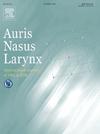单侧听力损失对听力损害的影响:日本标准化声音定位测试的多中心研究
IF 1.5
4区 医学
Q2 OTORHINOLARYNGOLOGY
引用次数: 0
摘要
本研究有两个主要目标:第一,标准化日本多家机构的声音定位测试;第二,使用该标准化测试分析单侧听力损失(UHL)患者的声音定位能力,并确定相关的临床和人口因素。方法在11个机构进行声音定位测试,纳入59例UHL受试者和77例正常听力对照(Ctrl)。研究的第一部分侧重于标准化测试方案,建立参考范围和截止值。第二部分分析了UHL患者的声音定位能力,采用均方根误差(RMS)测量。分析RMS值与残听、对侧信号传递(crs)助听器使用和成人听力障碍量表(HHIA)评分等因素之间的关系。结果成功建立了标准化声音定位试验的参考范围和截止值。与对照组相比,UHL受试者表现出显著更高的RMS值(即较差的定位)。使用CROS助听器并没有提高听力,而且峰诱发的频谱信号的贡献有限。RMS值与声音呈现位置和阈值高于40 dB和50 dB的听力图频率数量之间存在显著关联,其中50 dB阈值标准是一个更突出的因素。HHIA情绪和社会得分仅与年龄显著相关,而与声音定位表现或其他听力学因素无关。结论标准化声音定位测试是一种可靠的多中心研究工具。UHL患者的声音定位明显受损。受损耳的残余听力,即使有限,也有助于定位,而在我们的队列中,CROS助听器和单耳频谱线索的好处可以忽略。由于只有年龄会影响自我感知的听力障碍(HHIA评分),因此考虑恢复双耳听力不仅可以改善声音定位,还可以解决与UHL相关的更广泛的生活质量问题,这一点至关重要。本文章由计算机程序翻译,如有差异,请以英文原文为准。
Impact of hearing impairment in unilateral hearing loss: A multicenter study of standardized sound localization tests in Japan
Objective
This study had two primary objectives: first, to standardize a sound localization test across multiple facilities in Japan, and second, to use this standardized test to analyze sound localization ability in patients with unilateral hearing loss (UHL) and identify related clinical and demographic factors.
Methods
Sound localization tests were conducted at 11 facilities, enrolling 59 UHL subjects and 77 normal-hearing controls (Ctrl). The first part of the study focused on standardizing the test protocol and establishing reference ranges and cut-off values. The second part analyzed the sound localization ability in UHL patients, measured by the root mean squared (RMS) error. The association between RMS values and factors such as residual hearing, contralateral routing of signal (CROS) hearing aid use, and Hearing Handicap Inventory for Adults (HHIA) scores were analyzed.
Results
Reference ranges and cut-off values for the standardized sound localization test were successfully established. UHL subjects exhibited significantly higher RMS values (i.e., poorer localization) compared to controls. The use of CROS hearing aids did not improve performance, and the contribution of pinna-induced spectral cues was limited. Significant associations were found between RMS values and both sound presentation position and the number of audiogram frequencies with thresholds better than 40 dB and 50 dB, with the 50 dB threshold criterion being a more prominent factor. HHIA emotional and social scores were significantly associated only with age and not with sound localization performance or other audiological factors.
Conclusions
The standardized sound localization test proved to be a reliable tool for multicenter studies. Patients with UHL have significantly impaired sound localization. Residual hearing in the impaired ear, even if limited, was found to aid localization, whereas the benefits of CROS hearing aids and monaural spectral cues were negligible in our cohort. Since only age influenced the self-perceived hearing handicap (HHIA scores), it is crucial to consider restoring binaural hearing not just to improve sound localization but also to address the broader quality-of-life issues associated with UHL.
求助全文
通过发布文献求助,成功后即可免费获取论文全文。
去求助
来源期刊

Auris Nasus Larynx
医学-耳鼻喉科学
CiteScore
3.40
自引率
5.90%
发文量
169
审稿时长
30 days
期刊介绍:
The international journal Auris Nasus Larynx provides the opportunity for rapid, carefully reviewed publications concerning the fundamental and clinical aspects of otorhinolaryngology and related fields. This includes otology, neurotology, bronchoesophagology, laryngology, rhinology, allergology, head and neck medicine and oncologic surgery, maxillofacial and plastic surgery, audiology, speech science.
Original papers, short communications and original case reports can be submitted. Reviews on recent developments are invited regularly and Letters to the Editor commenting on papers or any aspect of Auris Nasus Larynx are welcomed.
Founded in 1973 and previously published by the Society for Promotion of International Otorhinolaryngology, the journal is now the official English-language journal of the Oto-Rhino-Laryngological Society of Japan, Inc. The aim of its new international Editorial Board is to make Auris Nasus Larynx an international forum for high quality research and clinical sciences.
 求助内容:
求助内容: 应助结果提醒方式:
应助结果提醒方式:


